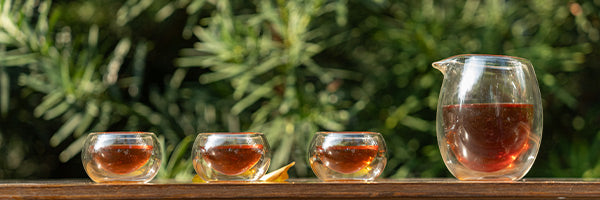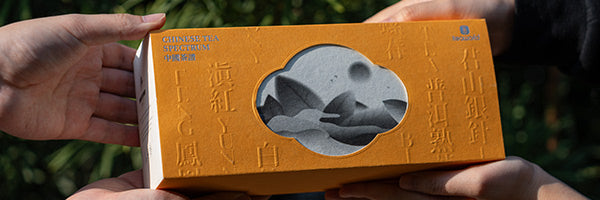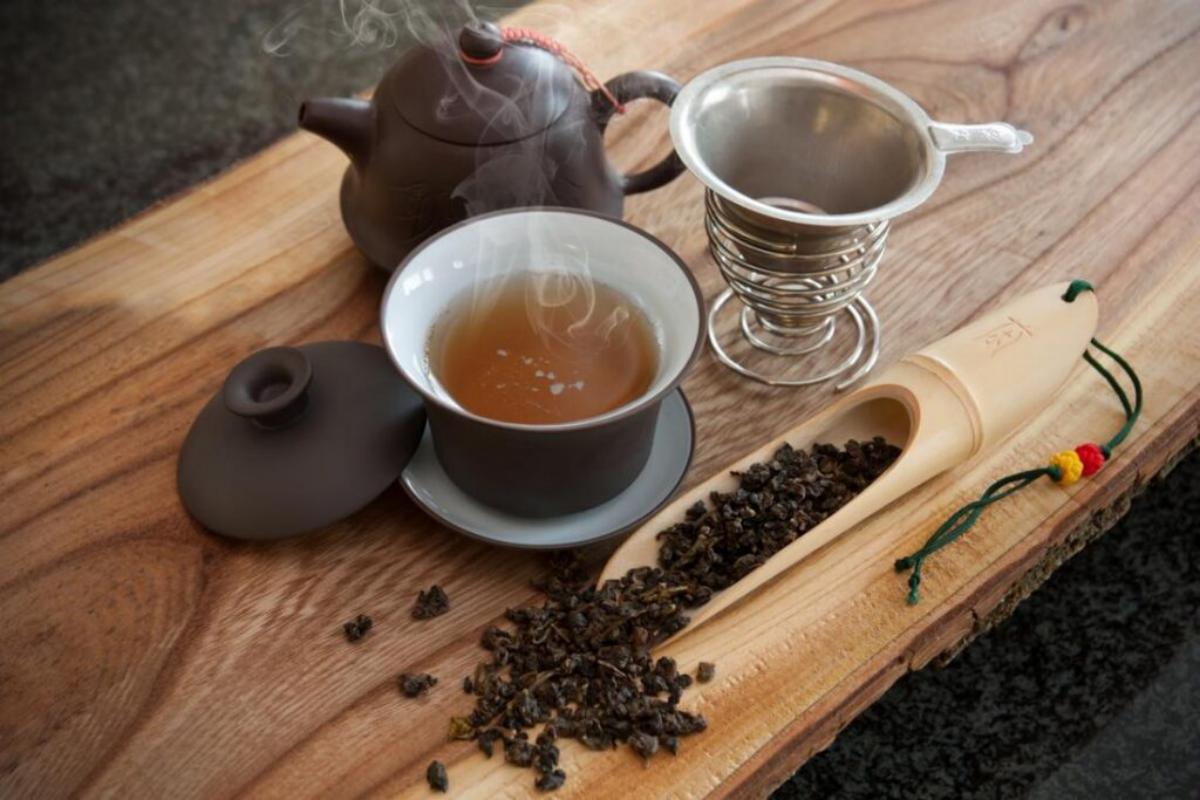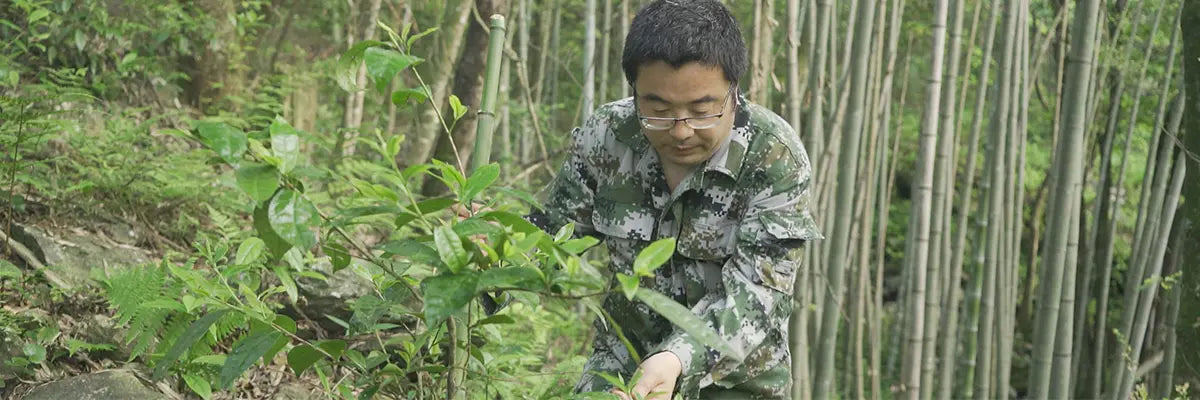Введение
Чай улун, с его богатой историей и пленительными вкусами, приобрел огромную популярность среди любителей чая по всему миру. От своего происхождения в Китае до мирового признания, чай улун предлагает разнообразный спектр вкусов и ароматов, которые могут поднять ваши впечатления от чая на новую высоту. В этой статье мы погрузимся в мир чая улун и рассмотрим пять обязательных к пробе сортов , которые наверняка очаруют ваши чувства и оставят неизгладимое впечатление.
I. Чай Те Гуаньинь Улун
TieGuanyin, настоящий и подлинный чай Anxi, служит для нас первым знакомством с миром улуна. Этот чай, родом из туманных гор Anxi в провинции Фуцзянь в Китае, может похвастаться уникальным вкусовым профилем, на который повлияла окружающая среда.
Аньси известен своими идеальными условиями для выращивания чая, большой высотой, обильными осадками и мягким климатом. Эти факторы способствуют развитию сложных вкусов и ароматов, которые можно найти в чае Тегуаньинь улун. Туманная атмосфера и богатая питательными веществами почва создают идеальные условия для цветения чайных кустов, в результате чего листья наполняются ароматом.
Название «ТеГуаньинь» переводится с английского как «Железная Богиня Милосердия», и оно занимает значительное место в китайской чайной культуре. Легенда гласит, что бедный фермер обнаружил полуразрушенный храм с железной статуей Гуаньинь, Богини Милосердия. В благодарность за ее благословения фермер заботился о храме и окружающих его чайных кустах. Чай, произведенный из этих кустов, стал известен как ТеГуаньинь , в знак уважения к благосклонной богине.
Чай TieGuanyin Oolong характеризуется тонким, но сложным вкусовым профилем. Он предлагает гармоничный баланс цветочных нот, таких как орхидея и сирень, с тонкими нотками жареных орехов и длительной сладостью. Чайные листья проходят тщательный процесс скручивания и обжаривания, что способствует его отличительной форме и вкусу.

II. Чай Миннан Нарцисс Улун
Наше путешествие продолжается в провинции Фуцзянь, где мы встречаем чай Minnan Narcissus Oolong. Этот замечательный чай получил свое название от региона Миннань, известного своими пышными пейзажами и традициями выращивания чая.
Что отличает чай Minnan Narcissus Oolong Tea от других, так это его уникальный процесс выращивания и сбора урожая. Чайные листья аккуратно собирают с 60-летних чайных деревьев, у которых были десятилетия, чтобы развить глубокую корневую систему и впитать сущность терруара. Эти зрелые деревья дают листья с исключительным вкусом и сложностью, что делает чай Minnan Narcissus Oolong Tea настоящим наслаждением для чувств.
Метаболический процесс этих старых листьев деревьев способствует формированию отличительных характеристик чая. Длительный период роста приводит к более высокому содержанию сахара и полифенолов, что усиливает естественную сладость и антиоксидантные свойства чая. При заваривании чай Minnan Shuixian Oolong раскрывает завораживающую гармонию вкусов с нотками меда, орхидеи и спелых фруктов, танцующими во рту.
Туманные высокие горы, окружающие регион Миннань, играют решающую роль в формировании качества этого чая. Высота и уникальный микроклимат создают идеальную среду для процветания чайных кустов. Туман, покрывающий склоны гор, питает чайные листья, наполняя их чистой сущностью природы. Результатом является чай, воплощающий в себе первозданную красоту и безмятежность своего окружения.
III. Чай Дахунпао Улун (Большой Красный Халат)
Далее мы отправимся в центр производства Дахунпао, где мы встретим легендарный чай Дахунпао Улун. Этот чай имеет почитаемый статус в мире Улунов, славится своими пленительными вкусами и захватывающей историей.
Дахунпао, также известный как Большой Красный Халат, берет свое начало в горах Уи в провинции Фуцзянь, Китай. Чайные кусты растут на скалистых утесах гор Уи, где они подвергаются воздействию стихий и процветают в сложных условиях. Уникальная богатая минералами почва и туманный влажный климат способствуют отличительному вкусовому профилю чая.
Название «Dahongpao» переводится с английского как «Большой красный халат» и имеет захватывающую историю. Легенда гласит, что во времена династии Мин родители ученого тяжело заболели. В отчаянии ученый обратился за помощью к монахам, проживавшим в горах Уи. Монахи предложили ему чай, который чудесным образом излечил его родителей. Исполненный благодарности, ученый накинул свой красный халат на чайные кусты в знак уважения и признательности. Чай, произведенный из этих кустов, стал известен как Dahongpao , символизирующий халат ученого.
Чай Дахунпао Улун известен своим особым вкусом «Янь», который относится к уникальным минеральным нотам, которые исходят от каменистой почвы гор Уи. Чайные листья проходят тщательный процесс скручивания, сушки и обжаривания, что усиливает его вкус и аромат. При заваривании чай Дахунпао Улун раскрывает восхитительное сочетание жареных орехов, карамели и тонкого оттенка цветочных оттенков.

IV. Чай Фэнхуан Даньцун Улун (Ми Лан Сян)
Наше исследование чая Улун переносит нас в очаровательное царство Фэнхуан Данконг, в частности, в пленительный сорт Ми Лань Сян. Этот чай, родом из гор Фэнхуан в провинции Гуандун, Китай, демонстрирует мастерство и сложность чаев Данконг.
Fenghuang Dancong , часто называемый Phoenix Dancong, получил свое название от горного хребта Fenghuang (Phoenix), известного своей захватывающей дух красотой и идеальными условиями для выращивания чая. Среди разнообразного ассортимента чаев Dancong Mi Lan Xiang выделяется своим уникальным ароматом и вкусовым профилем.
Mi Lan Xiang, что переводится как «Аромат медовой орхидеи», отражает суть своего названия. Чайные листья бережно собирают с древних чайных деревьев, которые выращивались поколениями. Особые методы выращивания и терруар гор Фэнхуан способствуют медовому аромату чая и стойким цветочным оттенкам.
Что отличает Mi Lan Xiang, так это его замечательная способность имитировать ароматы различных фруктов и цветов. При заваривании этот чай раскрывает целый оркестр вкусов с нотами меда, орхидеи, спелого персика и даже османтуса. Каждый глоток — это чувственное путешествие, вызывающее симфонию восхитительных и сложных вкусов.
Мастера гор Фэнхуан используют традиционные методы обработки чайных листьев. Листья тщательно скручиваются и формируются, что позволяет им сохранять свои уникальные характеристики. Результатом является визуально поразительный чай с профилем вкуса, который отражает разнообразные ароматы, встречающиеся в природе.
V. Выбор чая улун
Наш выбор чая Улун охватывает тщательно подобранный ассортимент исключительных чаев, воплощающих разнообразные вкусы и традиции Улуна. Каждый чай в этой коллекции был тщательно выбран, чтобы обеспечить захватывающий чайный опыт.
От нежных и цветочных нот Тегуаньинь до насыщенного и насыщенного минералами Дахунпао, наш выбор предлагает соблазнительный ассортимент чая Улун на любой вкус. Независимо от того, ищете ли вы освежающую и ароматную чашку или глубокий и сложный напиток, в нашем ассортименте чая Улун есть что-то, что удовлетворит ваш взыскательный вкус.
Мы закупаем наши улуны в известных регионах выращивания чая, гарантируя, что в нашу коллекцию попадают только самые качественные листья. Каждый чай проходит тщательную обработку, сохраняя свои уникальные характеристики и улавливая суть своего происхождения.
Побалуйте себя чарующими ароматами, тонкими вкусами и бархатистыми текстурами нашего Улунского чая Sampler . Откройте для себя чудеса Фэнхуан Даньцуна с его пленительным ароматом или насладитесь непреходящим очарованием Миннаньского нарцисса. Позвольте своим вкусовым рецепторам отправиться в путешествие по богатому гобелену Улунских чаев.
VI. Советы по завариванию чая улун для оптимального вкуса
Заваривание чая Улун требует точности и внимания к деталям, чтобы раскрыть весь его потенциал. Вот несколько важных советов по завариванию, которые улучшат ваши впечатления от чая Улун:

1. Температура воды:
Улун часто выигрывает от немного более высокой температуры воды по сравнению с зеленым чаем. Ориентируйтесь на диапазон 195-205°F (90-96°C), чтобы эффективно извлечь ароматы. Отрегулируйте температуру в зависимости от конкретного чая Улун, который вы завариваете.
2. Соотношение чая и воды:
Используйте примерно 1 чайную ложку листьев чая Улун на 8 унций (240 мл) воды. Отрегулируйте количество в зависимости от личных предпочтений и желаемой крепости вкуса.
3. Время настаивания:
Время заваривания чая улун может варьироваться в зависимости от типа чая и личных предпочтений. Начните с диапазона 2-4 минут и регулируйте соответственно. Более длительное время заваривания обычно приводит к более сильным вкусам, тогда как более короткое время обеспечивает более легкий напиток.
4. Многократные инфузии:
Улунские чаи часто подходят для многократных заварок, раскрывая разные слои вкуса с каждой заваркой. Экспериментируйте с более длительным временем заваривания для последующих заварок, поддерживая оптимальную температуру воды.
5. Чайная посуда:
Для заваривания чая улун используйте чайник или гайвань (традиционная китайская чаша с крышкой). Эти сосуды позволяют лучше сохранять тепло и оптимально извлекать ароматы. Избегайте использования металлических чайников, так как они могут испортить нежные ароматы чая.
6. Предварительный подогрев посуды для чая:
Перед завариванием ополосните чайник или гайвань горячей водой, чтобы предварительно прогреть его. Этот шаг помогает поддерживать температуру чая во время заваривания и обеспечивает более однородный вкусовой профиль.
7. Оцените ароматы:
Прежде чем сделать первый глоток, вдохните аромат заваренного чая Улун. Закройте глаза и позвольте пленительным ароматам перенести вас в место происхождения чая.
8. Наслаждайтесь:
Делайте маленькие глотки и позвольте вкусам раскрыться на вашем нёбе. Обратите внимание на развивающиеся вкусовые профили, от начальных нот до стойкого послевкусия. Задействуйте все свои чувства и полностью погрузитесь в опыт чая Улун.
Следуя этим советам по завариванию, вы сможете раскрыть истинный потенциал чая Улун и создать возвышенный опыт чаепития. С практикой и исследованием вы откроете для себя предпочтительные методы заваривания, чтобы каждый раз получать идеальную чашку чая Улун.
VII. Сочетание чая улун с едой для кулинарного приключения
Улунский чай предлагает широкий спектр вкусов и сложностей, которые можно прекрасно дополнить различными сочетаниями с едой. Вот девять предложений, которые помогут вам улучшить свои впечатления от чая Улун с помощью кулинарных исследований:

1. Светлые улуны (например, ТеГуаньинь, Нефритовый улун):
Эти чаи имеют нежные цветочные и фруктовые ноты. Сочетайте их с легкими и тонко ароматизированными блюдами, такими как приготовленные на пару морепродукты, суши или вегетарианские блюда. Нежные вкусы чая не перебьют еду, позволяя им обоим раскрыться.
2. Темные улуны (например, Дахунпао, Уи-Рок Улун):
Благодаря своему крепкому и поджаренному вкусу темные улуны хорошо сочетаются с жареным мясом, жареными овощами и пикантными блюдами. Землистые оттенки чая дополняют богатство этих блюд, создавая гармоничный баланс вкусов.
3. Цветочные улуны (например, Oriental Beauty, Mi Lan Xiang):
Эти чаи демонстрируют ароматические и цветочные профили. Сочетайте их с легкими десертами, такими как фруктовые тарты, выпечка с цветочным вкусом или нежные пирожные. Ароматные ноты чая усилят сладость и обеспечат восхитительный чувственный опыт.
4. Кремовые улуны (например, Цзинь Сюань, молочный улун):
Эти чаи имеют сливочный и маслянистый вкус. Они хорошо сочетаются с кремовыми десертами, такими как заварные кремы, крем-брюле или чизкейк. Богатая текстура и тонкая сладость чая создают роскошное сочетание.
5. Пряные улуны (например, Уи Роу Гуй, Фэнхуан Даньцун):
Эти чаи обладают уникальной пряностью и сложностью. Сочетайте их с пряными и ароматными блюдами, такими как тайская или индийская кухня. Смелые вкусы чая могут противостоять интенсивным специям, создавая яркое и запоминающееся сочетание.
6. Цитрусовые улуны (например, Хуан Цзинь Гуй, Алишань):
Эти чаи имеют яркие цитрусовые ноты. Сочетайте их с легкими салатами, севиче из морепродуктов или десертами с цитрусовыми нотками. Пикантные вкусы чая обеспечивают освежающий контраст и улучшают общее впечатление от еды.
7. Ореховые улуны (например, Бао Чжун, Хуан Гуань Инь):
Эти чаи имеют ореховые и жареные вкусы. Сочетайте их с жареным мясом, жареными овощами или десертами на основе орехов. Ореховые оттенки чая дополняют соленые или сладкие блюда, создавая гармоничное сочетание.
8. Шоколадные улуны (например, Цилан, Гуй Фэй):
Эти чаи имеют нотки шоколада и какао. Сочетайте их с десертами из темного шоколада, шоколадными трюфелями или безмучной выпечкой. Шоколадные нотки чая усиливают насыщенность и глубину лакомств на основе шоколада.
9. Сочетания с сыром:
Улун также можно употреблять с различными сырами. Светлые улуны хорошо сочетаются со свежими и мягкими сырами, такими как козий сыр, в то время как более темные и крепкие улуны можно сочетать с выдержанными и крепкими сырами, такими как чеддер или голубой сыр. Вкусы чая дополняют сливочные, соленые или острые профили различных сыров.
Помните, ключ к успешному сочетанию чая и еды — найти баланс, где вкусы чая и еды дополняют и усиливают друг друга. Экспериментируйте с различными сочетаниями, чтобы открыть свои личные предпочтения и отправиться в кулинарное приключение с чаями Улун в качестве вашего гида.
Наслаждаетесь ли вы традиционной чайной церемонией или просто наслаждаетесь чашкой чая улун во время еды, искусство сочетания чая с едой добавляет новое измерение к вашему опыту чаепития. Откройте для себя разнообразные вкусы чая улун вместе с различными кухнями и позвольте своим вкусовым рецепторам насладиться гармонией вкусов.
VIII. Хранение и сохранение срока годности чая улун
Чтобы обеспечить долговечность и сохранение вкуса и качества вашего чая Улун, необходимо правильное хранение. Следуйте этим рекомендациям, чтобы сохранить свежесть вашего чая Улун:

1. Выберите правильный контейнер:
Храните чай улун в герметичном контейнере, который непрозрачен или изготовлен из толстого, нереактивного материала, например, керамики, олова или темного стекла. Это помогает защитить чай от воздействия света, воздуха и сильных запахов.
2. Беречь от влаги:
Влага может ухудшить качество чайных листьев и способствовать росту плесени или грибка. Храните чай улун в сухом месте, вдали от влажности и источников влаги, таких как кухонная раковина или холодильник.
3. Избегайте жары и солнечного света:
Защищайте свой чай Улун от прямых солнечных лучей и чрезмерного тепла, так как они могут ускорить процесс деградации и привести к потере вкуса и аромата чая. Храните чай в прохладном и темном месте, например, в кладовой или шкафу.
4. Минимизируйте воздействие воздуха:
Кислород может вызвать окисление и порчу чайных листьев. При хранении чая улун минимизируйте воздействие воздуха, плотно закрывая контейнер после каждого использования. Рассмотрите возможность использования контейнеров меньшего размера, чтобы уменьшить количество воздуха, остающегося внутри.
5. Отделите сильные запахи:
Чай улун легко впитывает запахи. Держите его подальше от сильнопахнущих веществ, таких как специи, травы или ароматизированные продукты, чтобы чай не приобрел нежелательные привкусы.
6. Избегайте замораживания или охлаждения:
Хотя охлаждение или замораживание может показаться вариантом для длительного хранения, они могут ввести влагу и изменить вкус и аромат чая. Обычно рекомендуется хранить чай улун при комнатной температуре.
7. Срок годности монитора:
Улунский чай лучше всего употреблять в течение 6–12 месяцев с момента покупки для оптимального вкуса и свежести. Со временем чай может потерять свои яркие вкусы и стать несвежим. Наклеивайте этикетки на контейнеры с чаем с датой покупки, чтобы отслеживать его свежесть.
8. Качественная вода для пивоварения:
При приготовлении чая Улун используйте качественную фильтрованную или родниковую воду. Хлорированная или сильно минерализованная вода может повлиять на вкус чая. Свежая и чистая вода обеспечивает наилучшие результаты заваривания.
Соблюдая эти правила хранения, вы можете продлить срок годности и сохранить качество вашего чая Улун, гарантируя, что каждая чашка будет дарить богатые вкусы и сложные нюансы, которыми он славится. Наслаждайтесь путешествием по открытию постоянно меняющихся характеристик вашего чая Улун, смакуя каждую чашку.
IX. Чай улун и его потенциальная польза для здоровья
В дополнение к своему восхитительному вкусу и аромату, чай Улун ассоциируется с различными потенциальными преимуществами для здоровья. Хотя научные исследования продолжаются и индивидуальные результаты могут различаться, вот некоторые из часто обсуждаемых преимуществ для здоровья лучшего листового чая :
1. Управление весом:
Чай улун часто рекламируется за его потенциал для поддержания контроля веса. Он содержит полифенолы, которые могут помочь ускорить метаболизм и усилить окисление жиров. Регулярное употребление чая улун в сочетании со здоровым образом жизни может помочь в поддержании здорового веса тела.
2. Здоровье сердца:
Некоторые исследования показывают, что чай улун может оказывать положительное влияние на здоровье сердца. Антиоксиданты чая, такие как катехины и теафлавины, могут помочь снизить риск сердечно-сосудистых заболеваний за счет снижения уровня холестерина, улучшения артериального давления и содействия здоровой функции кровеносных сосудов.
3. Регуляция уровня сахара в крови:
Чай улун исследовался на предмет его способности регулировать уровень сахара в крови. Полифенолы в чае улун могут помочь улучшить чувствительность к инсулину и снизить риск развития диабета 2 типа. Однако важно отметить, что индивидуальные реакции могут различаться, и чай улун не является заменой медицинского лечения или здорового питания.
4. Антиоксидантные свойства:
Чай улун богат антиоксидантами, которые помогают бороться со свободными радикалами в организме, которые могут способствовать повреждению клеток и хроническим заболеваниям. Антиоксиданты в чае улун, включая катехины и теафлавины, могут оказывать защитное действие против окислительного стресса и поддерживать общее благополучие.
5. Здоровье пищеварительной системы:
Некоторые люди считают, что чай улун может помочь пищеварению и облегчить дискомфорт в пищеварительном тракте. Натуральные соединения чая могут помочь стимулировать пищеварительные ферменты, регулировать перистальтику кишечника и способствовать здоровому микробиому кишечника.
6. Умственная активность и концентрация внимания:
Чай улун содержит кофеин, который может помочь повысить бдительность и улучшить когнитивные функции. Сочетание кофеина и L-теанина, аминокислоты, содержащейся в чае, может способствовать ясности ума и концентрации, одновременно снижая потенциальное беспокойство, часто связанное с потреблением кофеина.
7. Здоровье кожи:
Антиоксиданты, присутствующие в чае Улун, могут способствовать поддержанию здоровья кожи. Эти антиоксиданты помогают защитить от окислительного повреждения и способствуют молодому цвету лица. Некоторые люди используют чай Улун местно или как часть своей процедуры по уходу за кожей, чтобы насладиться потенциальными преимуществами.
Важно отметить, что хотя чай улун может принести потенциальную пользу для здоровья, он не является панацеей от всех болезней, и индивидуальные результаты могут различаться. Как и в случае с любыми диетическими или связанными со здоровьем соображениями, рекомендуется проконсультироваться с врачом или зарегистрированным диетологом для получения персонализированных рекомендаций, основанных на ваших конкретных потребностях и обстоятельствах.
Кроме того, умеренность является ключевым фактором при употреблении чая Улун, поскольку он содержит кофеин. Содержание кофеина может варьироваться в зависимости от таких факторов, как время заваривания, температура воды и конкретный сорт чая Улун. При определении подходящего уровня потребления следует учитывать чувствительность к кофеину и состояние личного здоровья.

X. Заваривание чая улун: руководство по приготовлению и наслаждению
Заваривание чая Улун требует внимания к деталям и понимания характеристик чая для извлечения его оптимальных вкусов. Вот пошаговое руководство, которое поможет вам приготовить и насладиться восхитительной чашкой чая Улун:
1. Начните с качественного чая улун:
Выбирайте высококачественные листья чая Улун, которые соответствуют вашим вкусовым предпочтениям. Различные виды чая Улун могут иметь разную степень окисления и вкусовые характеристики, поэтому исследуйте и экспериментируйте, чтобы найти свои любимые варианты.
2. Соберите оборудование для пивоварения:
Подготовьте необходимое оборудование для заваривания, включая чайник или гайвань (китайская чаша с крышкой), чашки, ситечко для чая (при необходимости) и чайник для кипячения воды. Рекомендуется использовать специальный чайник для чая Улун, чтобы сохранить его неповторимые вкусы.
3. Температура воды:
Улун лучше всего заваривать при температуре воды от 176°F (80°C) до 203°F (95°C), в зависимости от конкретного сорта улуна. Более светлые улуны, такие как зеленые улуны, обычно требуют более низких температур, в то время как более темные улуны могут выдерживать более высокие температуры. Ознакомьтесь с упаковкой чая или проконсультируйтесь с продавцом чая для получения конкретных рекомендаций по завариванию.
4. Разогрейте чайник и чашки:
Перед завариванием предварительно прогрейте чайник и чашки, ополоснув их горячей водой. Этот шаг помогает поддерживать температуру чая во время заваривания и обеспечивает оптимальные вкусовые ощущения.
5. Измерьте чайные листья:
Используйте рекомендуемое количество чайных листьев в зависимости от желаемой крепости и размера вашего чайника. Как правило, используйте примерно 1-2 чайные ложки (2-3 грамма) чая Улун на 8 унций (240 мл) воды. Отрегулируйте количество в соответствии со своими вкусовыми предпочтениями.
6. Промойте чайные листья (по желанию):
Некоторые любители чая предпочитают промывать листья чая улун горячей водой перед самим процессом заваривания. Этот шаг помогает пробудить листья, удалить все примеси и подготовить их к последующим завариваниям. Вылейте воду для промывания.
7. Первое настой:
Залейте листья чая соответствующим количеством горячей воды, полностью покрыв их. Дайте чаю завариться в течение 1-2 минут для более светлых улунов и 2-3 минут для более темных улунов. Отрегулируйте время заваривания, чтобы достичь желаемой крепости. Избегайте чрезмерного заваривания, так как это может привести к горькому привкусу.
8. Разлейте и подавайте:
После желаемого времени настаивания аккуратно разлейте заваренный чай по чашкам через ситечко, если необходимо. Оцените аромат и цвет чая, пока вы его разливаете. Подавайте чай сразу, пока он еще горячий, смакуя вкусы и многогранность с каждым глотком.
9. Многократные инфузии:
Улунские чаи часто подходят для многократных заварок, каждая из которых предлагает уникальный вкус. Для последующих заварок увеличьте время заваривания на несколько секунд или минут, регулируя температуру воды по мере необходимости. Экспериментируйте и исследуйте развивающиеся нюансы чая с каждой заваркой.
10. Наслаждайтесь путешествием:
Не торопитесь, чтобы оценить тонкости чая Улун. Наблюдайте за цветом, ароматом и вкусом чая, которые развиваются в процессе заваривания. Задействуйте свои чувства и погрузитесь в процесс чаепития.
Помните, процесс заваривания можно регулировать в соответствии с личными предпочтениями и конкретными характеристиками чая улун, который вы используете. Не стесняйтесь экспериментировать с разным временем заваривания, температурой воды и соотношением чая и воды, чтобы найти свою идеальную чашку чая улун. Наслаждайтесь путешествием по открытию восхитительных нюансов и сложности, которые может предложить чай улун.
XI. Хранение чая улун: советы по сохранению свежести и вкуса
Правильное хранение необходимо для сохранения свежести, вкуса и аромата чая Улун с течением времени. Вот несколько советов, которые помогут вам эффективно хранить чай Улун:
1. Выберите герметичный контейнер:
Переложите листья чая Улун из оригинальной упаковки в герметичный контейнер. Выберите контейнер из непрозрачного материала, например, керамики, олова или темного стекла, чтобы защитить чай от воздействия света, влаги и сильных запахов.
2. Беречь от света и тепла:
Листья чая улун чувствительны к свету и теплу, что может ухудшить их качество. Храните емкость с чаем в прохладном, сухом месте, вдали от прямых солнечных лучей, плит и других источников тепла. Избегайте хранения чая улун в холодильнике, так как он может впитывать запахи других продуктов.
3. Минимизируйте воздействие воздуха:
Воздух может привести к потере вкуса и аромата чая Улун. Убедитесь, что выбранная вами емкость имеет плотно прилегающую крышку, чтобы минимизировать контакт с воздухом. Если ваша емкость больше, чем количество чая, рассмотрите возможность использования внутренней банки для хранения меньшего размера или добавления влаговпитывающего пакета, чтобы уменьшить количество воздуха внутри емкости.
4. Избегайте сырости и влажности:
Влажность и сырость могут привести к порче листьев чая улун. Держите емкость с чаем подальше от мест с высокой влажностью, таких как кухонная раковина или кипящие чайники. Кроме того, не храните чай улун в холодильнике, так как при перепадах температур на чае может образоваться конденсат.
5. Отделите сильные запахи:
Чай улун может поглощать сильные запахи из окружающей среды. Держите контейнер для чая подальше от специй, трав или сильно пахнущих предметов, чтобы предотвратить перекрестное загрязнение. При хранении нескольких сортов чая рассмотрите возможность использования отдельных контейнеров или отдельных герметичных пакетов, чтобы сохранить их различные вкусы.

6. Используйте чай в разумные сроки:
Чай улун лучше всего употреблять в течение определенного периода времени, чтобы насладиться его оптимальной свежестью и вкусом. Хотя он может сохранять свои качества от нескольких месяцев до года при правильном хранении, рекомендуется употреблять чай улун в течение 6-12 месяцев с момента покупки, чтобы получить наилучшие впечатления.
7. Не замораживайте чай улун:
Замораживание чая улун обычно не рекомендуется, так как это может негативно повлиять на вкус и текстуру листьев. При размораживании замороженного чая может накапливаться влага, что приводит к ухудшению качества. Лучше всего хранить чай улун при комнатной температуре.
Соблюдая эти правила хранения, вы можете продлить срок годности вашего чая Улун и гарантировать, что он сохранит свою свежесть и вкус с течением времени. Помните, что чай Улун лучше всего себя чувствует, если наслаждаться им относительно скоро после покупки, поэтому старайтесь регулярно употреблять и пополнять запасы, чтобы ощутить весь потенциал чая.
Заключение
Завершая наше путешествие по миру чая улун, мы надеемся, что вы глубже оценили разнообразие и сложность, которые предлагает этот чай. Пять обязательных к пробе сортов — Тегуаньинь, Миннань Нарцисс, Дахунпао, Фэнхуан Даньцун и Выбор чая улун — демонстрируют мастерство, наследие и уникальные вкусы, которые делают чай улун желанным напитком.
В iTeaworld мы с энтузиазмом доставляем лучшие чаи со всего мира к вашему порогу. Познакомьтесь с нашей коллекцией изысканных чаев улун, тщательно отобранных для обеспечения непревзойденного чайного опыта. От аутентичного ТеГуаньинь до пленительного Фэнхуан Даньцун, каждый чай рассказывает историю традиции и вкуса. Посетите iTeaworld Loose Leaf Tea , чтобы отправиться в собственное чайное путешествие и открыть для себя чудеса iTeaworld.
Поднимите свои чайные впечатления и насладитесь замечательными вкусами чая Улун . Почувствуйте мастерство и наследие, которые делают iTeaworld надежным именем в чае.












































































